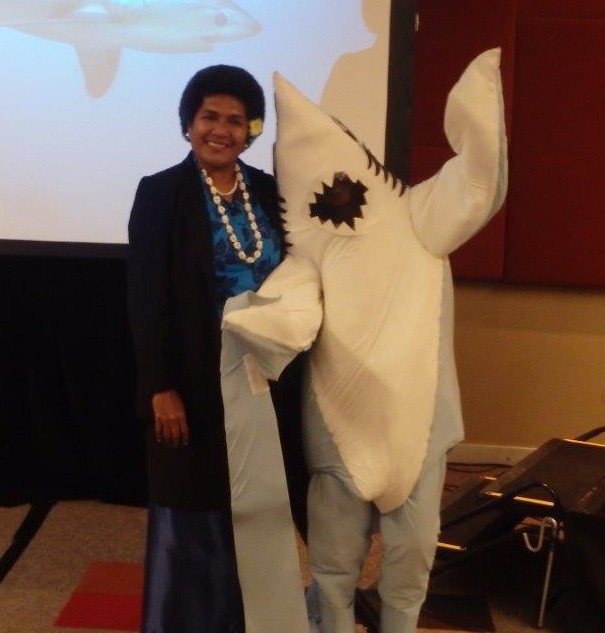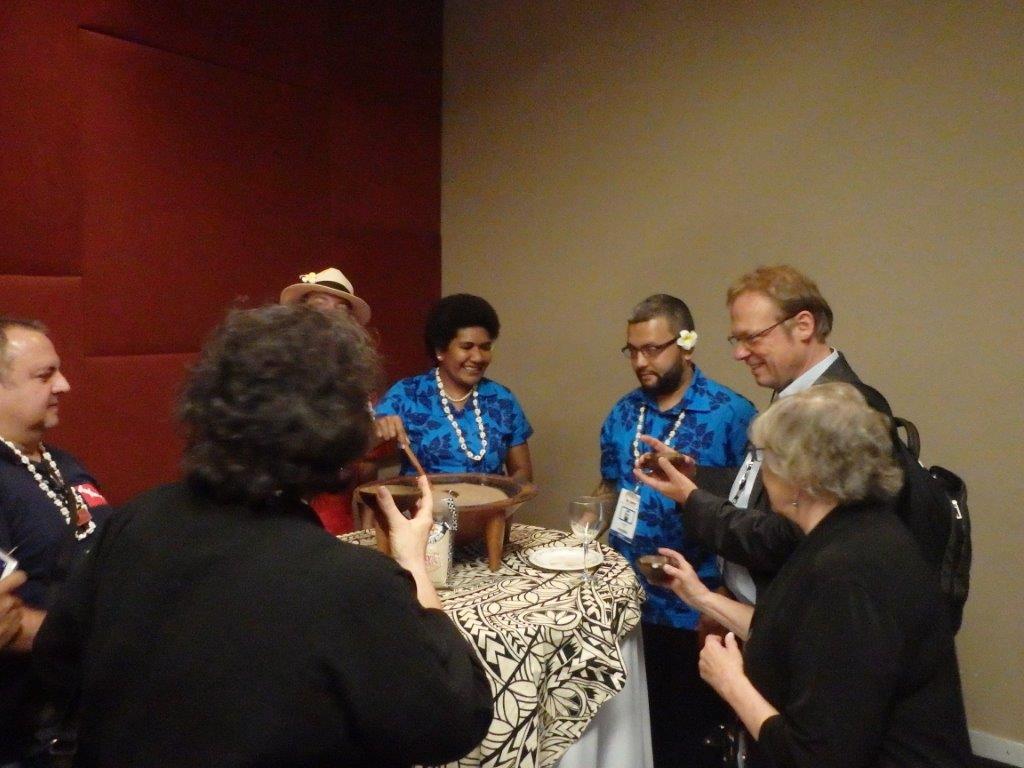
Biodiversity Conservation
SPREP has been working closely this year with Fiji and other Pacific island Parties to the Convention on International Trade of Endangered Species (CITES) to list 9 species of mobula rays on Appendix II, to arrest their recent dramatic declines. Fiji, Samoa and Palau are also co-sponsors of resolutions to list silky sharks and all three species of thresher sharks on Appendix II. Mr Mike Donoghue, the Threatened and Migratory Species Adviser of SPREP and Ms Juney Ward, the Shark and Ray Conservation Officer report from the frontline at the CITES COP in Johannesburg.
"Pacific island participants stole the limelight last night at a crowded side event, titled 'CITES, Sharks and Sustainable Livelihoods' (27 September, 2016) at the 17th Conference of Parties to CITES, which promoted the three resolutions that have been proposed for the protection of sharks and rays.
Listing any species on Appendix II of CITES requires both the exporting country and the importing country to issue certificates to confirm that trade in these species will be sustainable and will not endanger their conservation status.
 Eleni Tokaduadua, Principal Biodiversity Officer for the Department of Environment in Fiji with 'Shark Stanley' at the CITES COP side event. Photo: SPREP
Eleni Tokaduadua, Principal Biodiversity Officer for the Department of Environment in Fiji with 'Shark Stanley' at the CITES COP side event. Photo: SPREP
There are compelling reasons to list all the sharks and rays proposed for protection at this year's CITES meeting on the basis of their depletion in recent years because of over-fishing. Mobula rays, which are slightly smaller than the two species of manta rays that were listed at the last CITES conference, have been targeted mainly for their gills, which are much prized in Chinese medicine and can fetch up to $500 per kilo. Their exploitation has increased significantly since manta rays were listed by CITES.
Last night's side event, however, focused on the positive effects of conservation on community incomes. Most of the presentations were about the island of Malapascua in the Philippines, which was devastated by super-typhoon Haiyan in 2013. This island is one of the few places in the world where thresher sharks are regularly found in water close to shore but shallow enough for SCUBA divers to encounter them. Consequently, it has become a very popular dive spot in recent years, and diving resumed as a commercial activity within a few days of Haiyan, and provided an income for residents which was not available to other islands.
The inspirational stories told during the evening, however, were overshadowed by Mr Arthur Sokimi of Fiji who spoke from the heart about the significance of sharks and rays to Pacific islanders, and highlighted the efforts of SPREP and Pacific island countries to protect them. By the end of his presentation, several delegates were in tears, and the evening was rounded out perfectly by a gathering around the kava bowl.
 Participants gathering around the kava bowl at the conclusion of the evening's session. Photo: SPREP
Participants gathering around the kava bowl at the conclusion of the evening's session. Photo: SPREP
"The Pacific islands delegates are quietly hopeful that Fiji's mobula ray proposal will receive the necessary two-thirds majority for adoption when it comes up for debate, probably in three days' time. But there is plenty of opposition from countries with large fishing industries, and every vote will count.
If the side event firmed up some votes to support rays and sharks, it could have made a vital difference." – Mike and Juney, COP17, Johannesburg
The 17th meeting of the Conference of the Parties to CITES, the Convention on International Trade in Endangered Species of Wild Fauna and Flora is held in Johannesburg, South Africa from 24 September to 5 October 2016 at the Sandton Convention Centre.
"Pacific island participants stole the limelight last night at a crowded side event, titled 'CITES, Sharks and Sustainable Livelihoods' (27 September, 2016) at the 17th Conference of Parties to CITES, which promoted the three resolutions that have been proposed for the protection of sharks and rays.
Listing any species on Appendix II of CITES requires both the exporting country and the importing country to issue certificates to confirm that trade in these species will be sustainable and will not endanger their conservation status.
 Eleni Tokaduadua, Principal Biodiversity Officer for the Department of Environment in Fiji with 'Shark Stanley' at the CITES COP side event. Photo: SPREP
Eleni Tokaduadua, Principal Biodiversity Officer for the Department of Environment in Fiji with 'Shark Stanley' at the CITES COP side event. Photo: SPREPThere are compelling reasons to list all the sharks and rays proposed for protection at this year's CITES meeting on the basis of their depletion in recent years because of over-fishing. Mobula rays, which are slightly smaller than the two species of manta rays that were listed at the last CITES conference, have been targeted mainly for their gills, which are much prized in Chinese medicine and can fetch up to $500 per kilo. Their exploitation has increased significantly since manta rays were listed by CITES.
Last night's side event, however, focused on the positive effects of conservation on community incomes. Most of the presentations were about the island of Malapascua in the Philippines, which was devastated by super-typhoon Haiyan in 2013. This island is one of the few places in the world where thresher sharks are regularly found in water close to shore but shallow enough for SCUBA divers to encounter them. Consequently, it has become a very popular dive spot in recent years, and diving resumed as a commercial activity within a few days of Haiyan, and provided an income for residents which was not available to other islands.
The inspirational stories told during the evening, however, were overshadowed by Mr Arthur Sokimi of Fiji who spoke from the heart about the significance of sharks and rays to Pacific islanders, and highlighted the efforts of SPREP and Pacific island countries to protect them. By the end of his presentation, several delegates were in tears, and the evening was rounded out perfectly by a gathering around the kava bowl.
 Participants gathering around the kava bowl at the conclusion of the evening's session. Photo: SPREP
Participants gathering around the kava bowl at the conclusion of the evening's session. Photo: SPREP"The Pacific islands delegates are quietly hopeful that Fiji's mobula ray proposal will receive the necessary two-thirds majority for adoption when it comes up for debate, probably in three days' time. But there is plenty of opposition from countries with large fishing industries, and every vote will count.
If the side event firmed up some votes to support rays and sharks, it could have made a vital difference." – Mike and Juney, COP17, Johannesburg
The 17th meeting of the Conference of the Parties to CITES, the Convention on International Trade in Endangered Species of Wild Fauna and Flora is held in Johannesburg, South Africa from 24 September to 5 October 2016 at the Sandton Convention Centre.